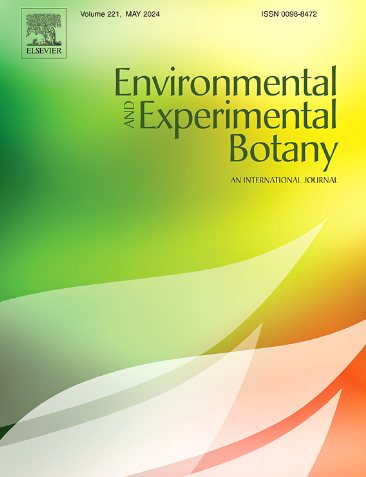Decreasing R:FR ratio in a grow light spectrum increases inflorescence yield but decreases plant specialized metabolite concentrations in Cannabis sativa
IF 4.5
2区 生物学
Q2 ENVIRONMENTAL SCIENCES
引用次数: 0
Abstract
Cultivation of Cannabis sativa for recreational and pharmaceutical purposes has been increasing significantly in recent years due to legalization in many countries. Cultivation takes place regularly indoors under varying artificial lighting sources. There is a lack of scientific knowledge on the effect of light spectrum on the C. sativa morphology, yield, and quality, especially the cannabinoid and terpene concentrations in the female inflorescences in indoor environments. Furthermore, only a handful of the spectra studies conducted so far study or discuss the effect of far-red radiation, while the effect of other wavelengths, such as UV or blue, has gained more attention. This study had two aims: (1) to examine plant morphology and inflorescence yield under varying red to far-red ratio (R:FR) treatments with equal photon flux densities (380–780 nm), and (2) to examine the possible relationship of the cannabinoid and terpene concentrations with the spectrum’s R:FR ratio, Plant material was collected as cuttings from C. sativa ‘Finola’ mother plants and grown under 18 h photoperiod before transferring them under the light treatments for 49 days (550 μmol m−2 s−1, 12 h/12 h dark/light). Light treatments were created with two types of LED fixtures, white spectrum (380–780 nm) and far-red (730 nm), which were used to create four R:FR ratio treatments; R:FR 3, 5, 9, and 12. Plant morphology was affected by the R:FR ratio; under the lowest R:FR (3) treatment plants were tallest, and the apical inflorescence dry weight decreased linearly with increasing R:FR ratio. The concentrations of many terpenes and cannabinoids including cannabidiolic acid (CBDA), tetrahydrocannabinolic acid (THCA), and cannabigerolic acid (CBGA), increased with increasing R:FR ratio. In conclusion, spectra with different R:FR ratios can be used as a tool at different growth phases to modify the plant morphology, inflorescence yield, and cannabinoid and terpene concentrations.
在生长光谱中R:FR比值的降低增加了大麻的花序产量,但降低了植物特化代谢物浓度
近年来,由于许多国家的大麻合法化,用于娱乐和制药目的的大麻种植一直在显著增加。种植在不同的人工照明光源下定期在室内进行。在室内环境下,光谱对大麻的形态、产量和品质的影响,特别是对大麻素和萜烯在雌花花序中的含量的影响,目前还缺乏科学的认识。此外,迄今为止进行的光谱研究中,只有少数研究或讨论了远红色辐射的影响,而其他波长(如紫外线或蓝色)的影响得到了更多的关注。这项研究有两个目的:(1)为了研究在相同光子通量密度(380 ~ 780 nm)下不同红远红比(R:FR)处理下的植株形态和花序产量;(2)为了研究大麻素和萜类浓度与光谱R:FR比值的可能关系,从C. sativa ‘ Finola ’母株上采集植物材料,在18 h光周期下生长,然后将其转移到光处理(550 μmol m−2 s−1,12 h/12 h暗/光处理)下49天。使用两种类型的LED灯具进行光处理,白色光谱(380-780 nm)和远红色(730 nm),用于创建四种R:FR比率处理;R:FR 3、5、9和12。R:FR对植株形态有影响;低R:FR(3)处理下植株最高,顶端花序干重随R:FR的增加呈线性下降。大麻二酚酸(CBDA)、四氢大麻酚酸(THCA)和大麻二酚酸(CBGA)等萜烯和大麻素的浓度随R:FR的增加而增加。综上所述,不同R:FR比值的光谱可以作为一种工具,在不同的生长阶段改变植物形态、花序产量以及大麻素和萜烯浓度。
本文章由计算机程序翻译,如有差异,请以英文原文为准。
求助全文
约1分钟内获得全文
求助全文
来源期刊

Environmental and Experimental Botany
环境科学-环境科学
CiteScore
9.30
自引率
5.30%
发文量
342
审稿时长
26 days
期刊介绍:
Environmental and Experimental Botany (EEB) publishes research papers on the physical, chemical, biological, molecular mechanisms and processes involved in the responses of plants to their environment.
In addition to research papers, the journal includes review articles. Submission is in agreement with the Editors-in-Chief.
The Journal also publishes special issues which are built by invited guest editors and are related to the main themes of EEB.
The areas covered by the Journal include:
(1) Responses of plants to heavy metals and pollutants
(2) Plant/water interactions (salinity, drought, flooding)
(3) Responses of plants to radiations ranging from UV-B to infrared
(4) Plant/atmosphere relations (ozone, CO2 , temperature)
(5) Global change impacts on plant ecophysiology
(6) Biotic interactions involving environmental factors.
 求助内容:
求助内容: 应助结果提醒方式:
应助结果提醒方式:


